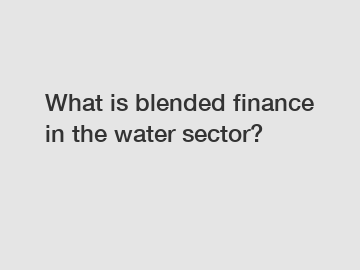What is blended finance in the water sector?
Blended Finance in the Water Sector: Enhancing Sustainability and Access.
The water sector is facing significant challenges in meeting the growing demand for clean water and sanitation services. Blended finance has emerged as a solution to attract private sector investment and improve the sustainability and accessibility of water-related projects. In this article, we will explore what blended finance means in the water sector and its potential benefits for both investors and communities.
Understanding Blended Finance.

Blended finance refers to the strategic use of public and private funds, together with philanthropic and impact investment, to mobilize capital for development projects. It involves combining different types of financing to leverage resources and address market barriers. In the context of the water sector, blended finance aims to bridge the funding gap and accelerate the achievement of Sustainable Development Goal 6: Ensure availability and sustainable management of water and sanitation for all.
Blended Finance Mechanisms.
There are various blended finance mechanisms that can be applied in the water sector. These include:
1. Concessional Loans: This mechanism involves providing loans with below-market interest rates or longer repayment periods to reduce the financial risk for investors and attract private sector participation in water projects.
2. Performance-Based Grants: In this approach, grants are provided to projects based on specific performance targets, such as increasing access to clean water or improving water management practices. These grants incentivize private sector involvement and ensure the achievement of desired outcomes.
3. Outcome Funding: This mechanism involves providing payments based on the achievement of predefined outcomes, such as reduced water wastage or increased water quality. Outcome funders bear the risk of project failure but also benefit from successful outcomes.
4. Blended Debt and Equity Instruments: Combining debt and equity instruments allows investors to have a diversified portfolio and manage risks effectively. This approach enables water projects to attract different types of investors with varying risk profiles.
Benefits of Blended Finance in the Water Sector.
Blended finance offers numerous benefits for both investors and communities in the water sector:
1. Increased Financial Sustainability: By leveraging public and private funds, blended finance diversifies the sources of funding for water projects, reducing the burden on governments and donors. This approach makes projects financially viable and sustainable in the long term.
2. Enhanced Access to Capital: Blended finance attracts private sector investment by providing appropriate risk-sharing mechanisms. This increases the availability of capital for water-related projects, enabling them to reach more communities and achieve broader impact.
3. Improved Project Quality: The involvement of private sector investors often brings technological expertise, innovation, and efficient project management practices. This leads to higher-quality projects and better delivery of water services.
4. Accelerated Achievement of SDG 6: Blended finance can mobilize the necessary resources and accelerate progress towards achieving SDG 6. By leveraging private sector capital and expertise, blended finance can significantly increase the number of people accessing clean water and sanitation services.
Conclusion.
In conclusion, blended finance is a powerful tool for attracting private sector investment and improving the sustainability and accessibility of water-related projects. Through various mechanisms, blended finance allows public and private funds to be combined strategically, addressing market barriers and mobilizing capital for the water sector. The benefits of blended finance include increased financial sustainability, enhanced access to capital, improved project quality, and accelerated achievement of SDG 6. It is evident that blended finance has the potential to revolutionize the water sector, ensuring a better future for all.
For more information on blended finance in the water sector, please contact us.
For more information, please visit movable weir, Containerized Water Purification Plant, Simplified Elevated Dam.

Comments
0